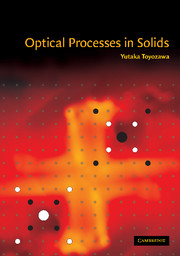Book contents
- Frontmatter
- Contents
- Preface
- Acknowledgments
- List of principal symbols
- 1 Radiation field
- 2 Quantum mechanics
- 3 Interaction of radiation with matter
- 4 Electronic vs. nuclear motions and the optical spectra of localized electrons in solids
- 5 Lattice vibrations
- 6 Electric susceptibility and dielectric constant
- 7 One-electron states in solids
- 8 Excitons
- 9 Polaron and the self-trapped state
- 10 Optical spectra of exciton in the phonon field Overview
- 11 Higher-order optical processes
- 12 Inner-shell excitation
- 13 Photo-induced structural changes
- 14 Light, matter and life (A scenario for the origin of life and its evolution)
- Appendix 1 Derivation of exciton Hamiltonian from many-body Hamiltonian
- Appendix 2 Transient spectra for second-order optical processes
- References (by chapter)
- Subject index
13 - Photo-induced structural changes
Published online by Cambridge University Press: 10 December 2009
- Frontmatter
- Contents
- Preface
- Acknowledgments
- List of principal symbols
- 1 Radiation field
- 2 Quantum mechanics
- 3 Interaction of radiation with matter
- 4 Electronic vs. nuclear motions and the optical spectra of localized electrons in solids
- 5 Lattice vibrations
- 6 Electric susceptibility and dielectric constant
- 7 One-electron states in solids
- 8 Excitons
- 9 Polaron and the self-trapped state
- 10 Optical spectra of exciton in the phonon field Overview
- 11 Higher-order optical processes
- 12 Inner-shell excitation
- 13 Photo-induced structural changes
- 14 Light, matter and life (A scenario for the origin of life and its evolution)
- Appendix 1 Derivation of exciton Hamiltonian from many-body Hamiltonian
- Appendix 2 Transient spectra for second-order optical processes
- References (by chapter)
- Subject index
Summary
Overview
In this chapter, we will consider the origin and nature of interatomic bonds in the context of optical transitions and subsequent atomic rearrangements. In ordinary textbooks on the solid state, the description of interatomic bonds is put in earlier chapters because that is the very basis of the microscopic structures of matter inclusive of the condensation mechanisms which govern their thermal, electric, magnetic and optical properties. The reason we have delayed our consideration of these aspects until the penultimate chapter in this book is that optical excitation often causes a drastic change in the interatomic bond (inclusive of bond creation and annihilation) which is reflected in and thus revealed by, the optical spectra (emission, as well as absorption spectra) themselves. Thus, the spectroscopic study sheds new light on the nature of interatomic bonds in condensed matter.
Of course, we are well aware of the nature of interatomic bonds in familiar materials. However, interatomic forces acting upon any particular atom are altogether in balance in the ground electronic state of the material (however large an individual force may be), so that there is no way of singling out a force between any particular pair of atoms as long as the system stays in the ground state.
- Type
- Chapter
- Information
- Optical Processes in Solids , pp. 319 - 370Publisher: Cambridge University PressPrint publication year: 2003



